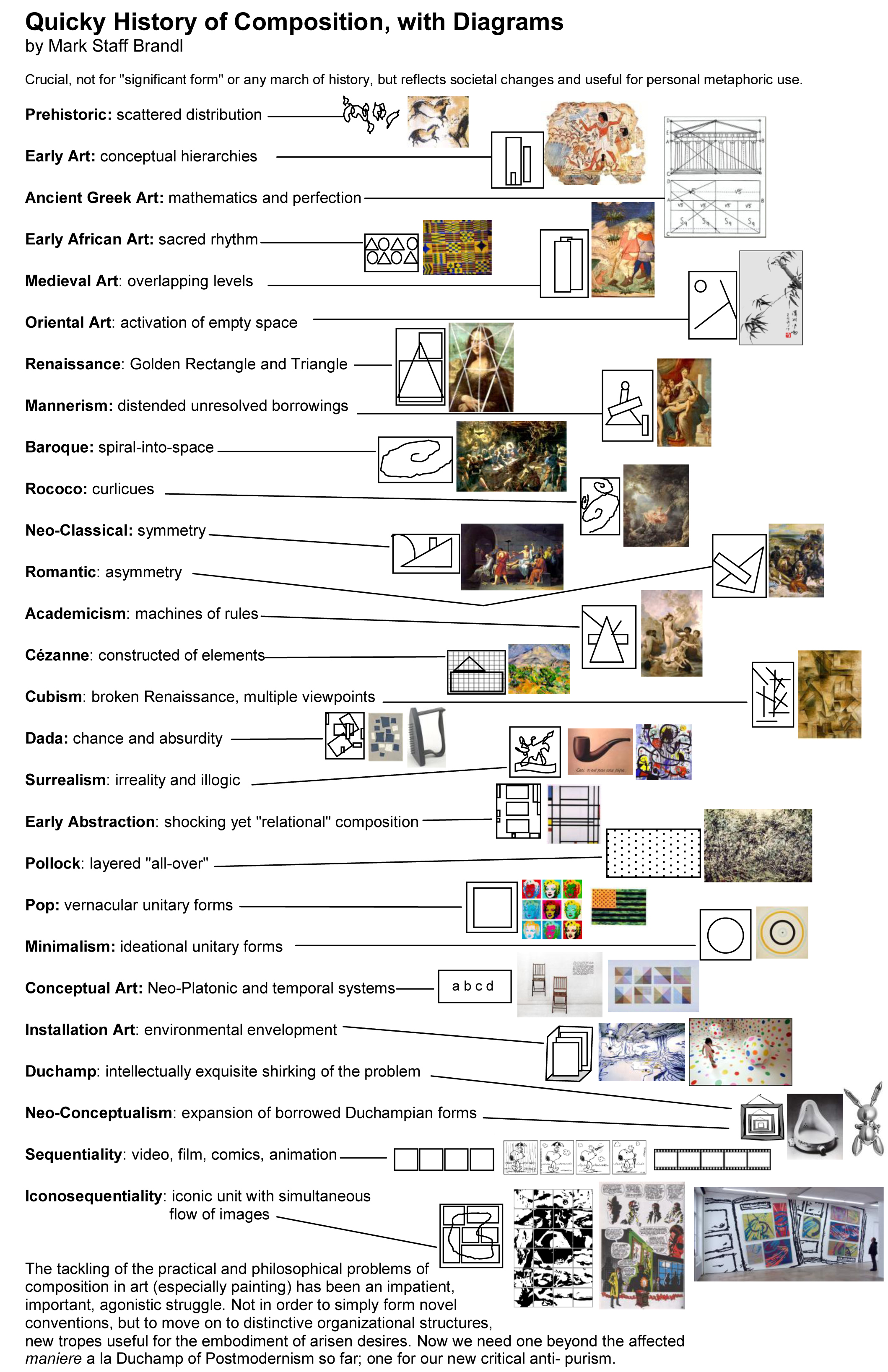A History of Composition—as Metaphor
by Mark Staff Brandl
Before you compose your artwork it’s a good idea to ask yourself why you’re doing it. Anonymous
This week’s article is in the form of a chart with only a few introductory remarks.
Composition is generally heralded as important to art, yet in actuality it is taught as if it is only a secondary matter of learning how to “balance elements.” This is especially true of the semi-Bauhaus tradition which most artists and all designers have learned for about 80 years. It is, however, far more than the placement and arrangement of visual elements within a work of art in a fashion to be “pleasing to the eye,” or in order the “lead the eye through the work.” Most of all, compositional form has inherent metaphoric associations, content if you will. In deed, it has been one of the, if not THE, major ways in which art has changed through the ages. Composition is crucial, not for a Greenbergian theoretical development of “significant form” or for any conception of a march of history for its own sake, but rather because compositional form reflects societal changes, expresses the “climate” of the times, the paideuma of the culture—and is ultimately invaluable for personal metaphoric use by artists.
Art has had enlightening and liberating developments reached by artists struggling with all the aspects of the various disciplines and mediums. In this short overture I cannot describe them all. In fact, that would be a great book in itself. Let me simply list a few discoveries or inventions and evolutions that have allowed artists to express their own and their cultures’ hopes, desires, problems and promise: the concentration on the brushstroke by the Impressionists to express light; van Gogh’s brushstrokes to express emotion; the enhanced three-dimensionality of Bernini’s sculpture to express vivacity; Matisse’s freeing of color; and then there is surface and transparency and camera-angles and editing and and and…
Here, focusing on 2-D work (yet not exclusively) simply for simplicity in a diagram, I have outlined the chief developments in compositional forms from prehistoric through Postmodernism, as I see them, ignoring the equally important and vast array of other issues for the moment. The historical transformation of one’s inherited dominant compositional form has been one of the chief arenas of struggle for artists. Throughout history, far more, for example, have discussed this and what they feel was their contribution than have discussed almost any other topic (including personal emotions or philosophy, surprising as that may seem today). I go from the haphazard form in prehistory reflecting their unity of art, religion and magic up through the enthroning of the readymade in Postmodern Neo-Conceptualism. After that I suggest a further development happening largely outside the fine artworld, yet influencing it, that of sequentiality, and finally I suggest my own solution to the problem, iconsequentiality. Yet I believe there must now be a variety of personal experiments and solutions.
I think it is important to once again begin to struggle for our own compositional forms as this has largely been abandoned since the end of Modernism. (This is a tendency in every manneristic and academicist transition period in the past as well, when forms become codified rather than thrown into question as they should be.) As I say at the bottom of my chart, “the tackling of the practical and philosophical problems of composition in art (especially in painting) has been an impatient, important, agonistic struggle. Not in order to simply form novel conventions, but to move on to distinctive organizational structures, new tropes useful for the embodiment of arisen desires. Now we need one beyond the affected maniere à la Duchamp of Postmodernism so far; one for our new critical anti- purism.”
